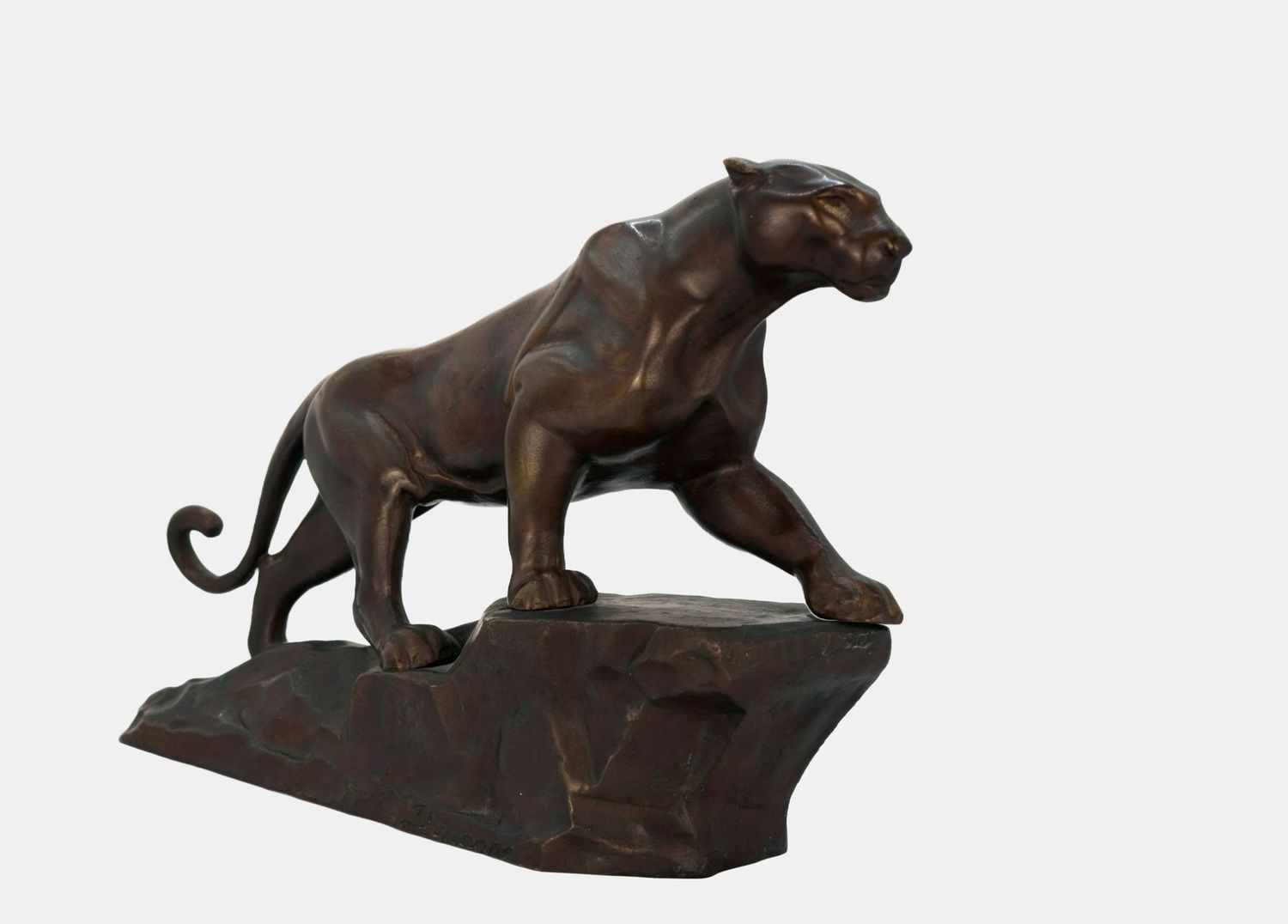Dupagne, Arthur (1895-1961), Emporschreitender Panther, um 1938
Arthur Dupagne(1895 Lüttich - 1961 Woluwe-Saint-Pierre), Emporschreitender Panther , um 1938. Patinierte Bronze in Vollguss auf hohlgegossenem Terrainsockel, im Guss mit „Dupagne“ signiert, 22 cm (Länge) x 13,5 cm (Höhe) x 6 cm (Breite), 1,35 kg.
- Patina etwas berieben, stellenweise leicht bestoßen, insgesamt gut erhalten.
- Die kraftvolle Eleganz des Animalischen -
Der kraftvolle Panther schreitet eine Felsformation hinauf und hält am Rand, den er mit seiner linken Tatze überragt, inne, um in die Ferne zu spähen. Er scheint sein Reich zu überblicken und dabei zugleich nach Beute Ausschau zu halten. Auch wenn das Raubtier innehält, mag sich der Bewegungsimpuls des Hinaufschreitens im nächsten Moment in einem mächtigen Sprung fortsetzen, schließlich scheint der Panther bereits Witterung und Sichtkontakt aufgenommen zu haben.
Die treppenartig angelegte Felsformation präsentiert die bis in die Schwanzspitze hinein präsente Kraftfülle des Panthers in der Eleganz seiner geschmeidig-machtvollen Bewegung. Arthur Dupagne hat diese Bewegungen sicherlich in natura studiert und doch formuliert er die Muskulatur in der geometrisierten Formensprache des Art Déco. Dadurch wird der Panther jedoch nicht in ein abstraktestes Kunstwesen verwandelt, sondern die Kraftfülle und die spannungsvolle Dynamik seiner inneren Bewegtheit umso mehr zum Ausdruck gebracht. Dupagne überführt hier auch seine im Kongo gesammelten künstlerischen Erfahrungen einer kraftvoll ursprünglichen afrikanischen Kunst ins Art Déco.
Mit dem Symbolismus wurde der Löwe vom Panther abgelöst. Das königlich Sonnenhafte des Löwen wich dem geheimnisvoll Nächtlichen des schwarzen Panthers, dem – als Begleittier des Dionysos – zugleich die Unberechenbarkeit des Rauschhaften anmutet.
zum Künstler
Trotz seiner früh zutage tretenden künstlerischen Begabung, absolvierte Arthur Dupagne nach einer Lehre in der Schmiedewerkstatt seines Vaters auf Wunsch seiner Eltern ein technisches Studium, besuchte aber dennoch Abendkurse für Bildhauerei an der Kunstakademie Lüttich. Jede der besuchten Klassen schloss er mit Auszeichnung ab und stellte erstmals im Salon von 1924 seine Werke aus.
Aufgrund familiärer finanzieller Schwierigkeiten trat Dupagne eine Stelle als Ingenieur in Belgisch-Kongo an, wo er sich von 1927 bis 1935 in Tshikapa aufhielt. Neben seiner beruflichen Tätigkeit widmete er sich intensiv der Bildhauerei und wurde dabei von den Skulpturen der Stämme der Tshorkwé, Mumpende und Bassala inspiriert. Die zahlreichen, vor allem in Ton angefertigten Entwürfe und Modelle dienten ihm nach seiner Rückkehr nach Brüssel als Vorlage für Stein-, und Bronzearbeiten. Die Ausstellung dieser Werke führten zum künstlerischen Durchbruch. Fortan widmete sich Dupagne ganz der Kunst. Er wurde mit zahlreichen staatlichen Aufträgen für öffentliche Standbilder und Porträtbüsten der Königsfamilie bedacht, was in dem Auftrag gipfelte, die Königin Astrid zu proträtieren.
Arthur Dupagne war auf den Weltausstellungen von Paris (1937) und New York (1939) vertreten. Für sein künstlerisches Werk erhielt Dupagne 1940 den Ordre de la Couronne und 1952 den hochdotierten Ordre Royal du Lion .

